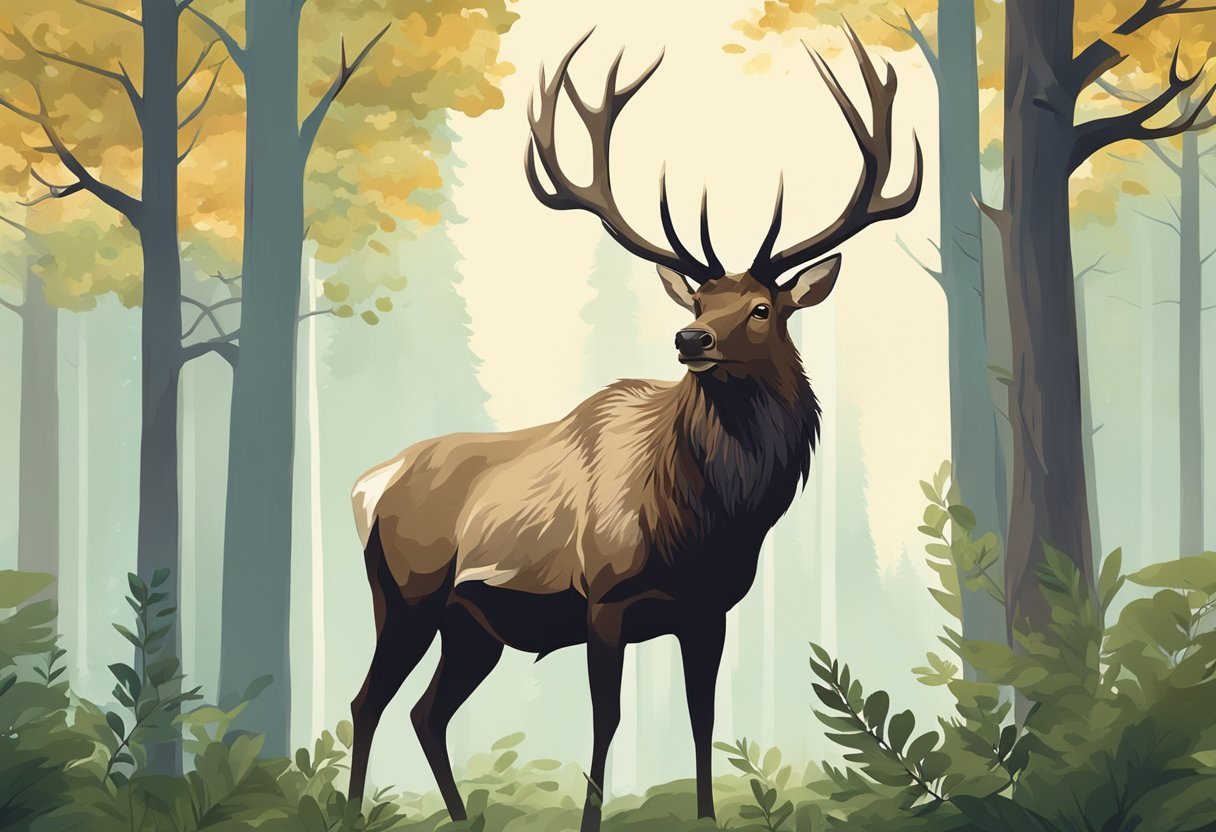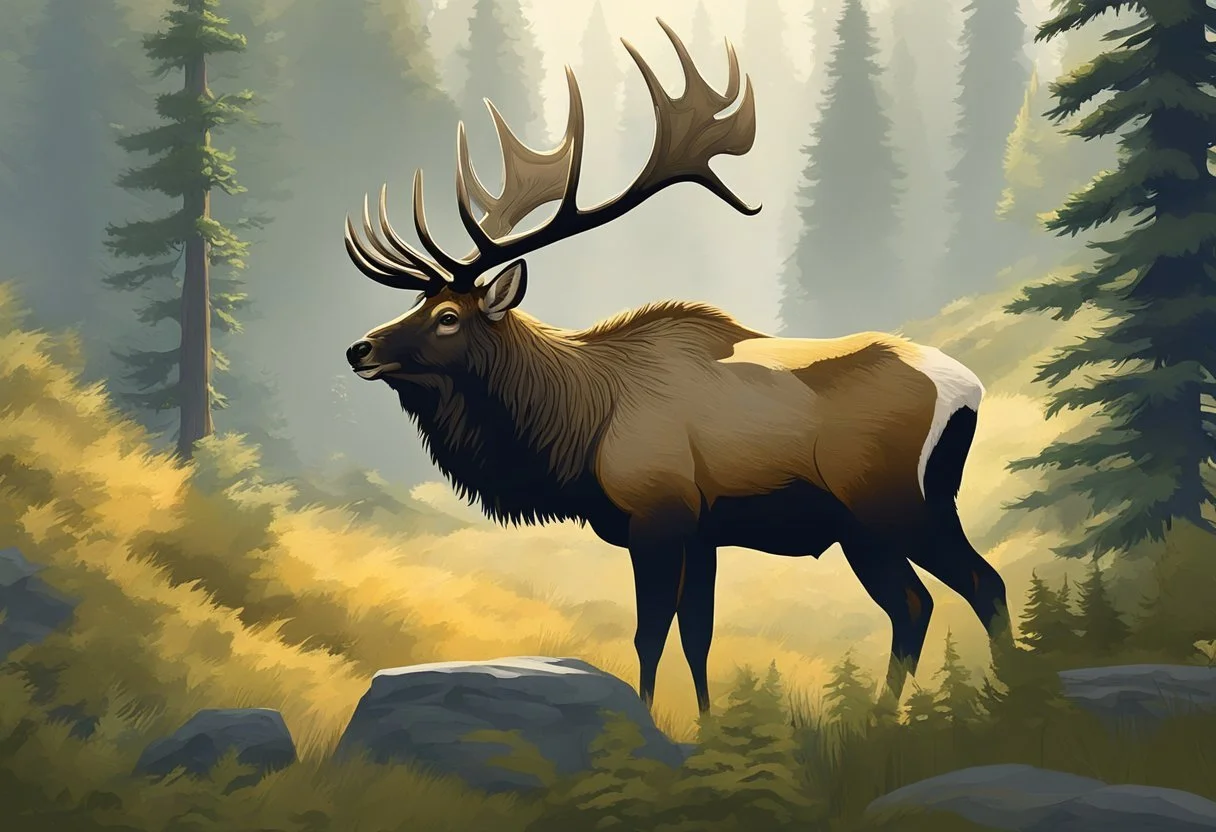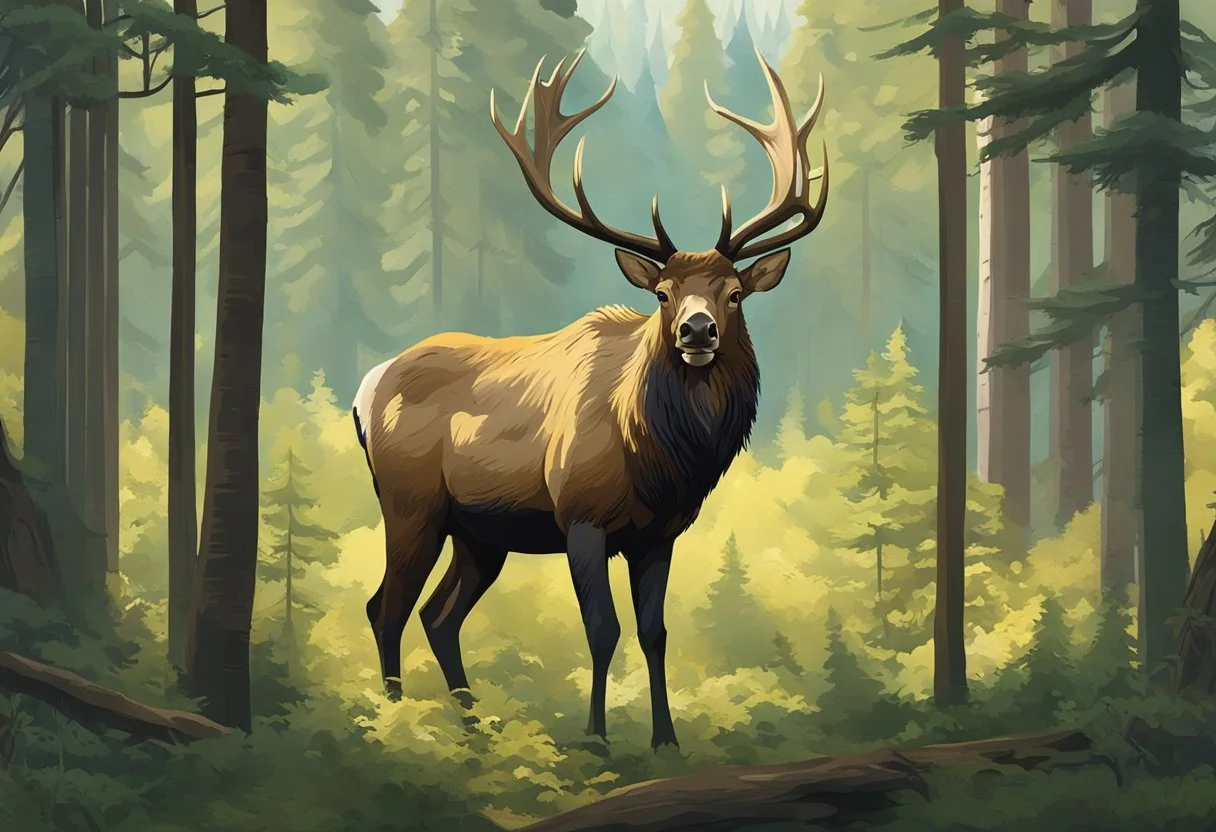World Record Elk
Unveiling the Most Impressive Antlers to Date
Discover > Texas Outdoorsman > World Record Elk
The pursuit of world record elk is a thrilling experience for many hunters and enthusiasts who are passionate about wildlife conservation efforts. Bagging these majestic creatures elk antlers as trophies is often seen as a testament to a hunter's skill, but it goes way beyond bragging rights. Behind the scenes, avid hunters play a crucial role in promoting and contributing to the conservation of not only American elk but also their habitats, ensuring a healthy balance of wildlife populations.
Record-keeping organizations maintain comprehensive records documenting the top elk specimens hunters took to sustain these conservation efforts. These records, however, serve a purpose greater than just competition among hunters. They provide valuable data that helps wildlife management agencies and conservation groups study and monitor wildlife populations' health and progress.
Trophy hunting, when managed and regulated properly, can be an essential tool in preserving ecosystems and enhancing the vibrancy of local wildlife. By taking pride in the pursuit of world record elk and responsibly adhering to guidelines, hunters contribute significantly to essential conservation efforts, safeguarding the future of these incredible American elk and their habitats.
History of Elk World Records
Early Record Holders
Throughout history, elk hunters have pursued the largest elk ever, and the most remarkable specimens to beat the previous world record. In the early days, each world record was primarily based on antler size, measured in inches of spread or points. Some notable record holders from this time include the famous Spider Bull, taken in 2008 by Denny Austad. This impressive giant bull had a score of 499 3/8 inches, its unique and massive antlers earning it a rightful place in the history books.
The Boone & Crockett Club's Role
The Boone & Crockett Club (B C), founded in 1887 by Theodore Roosevelt and George Bird Grinnell, has played a crucial role in elk world records. The Crockett Club mission is to promote conservation and fair chase hunting while maintaining a record-keeping system that captures the achievements of hunters. All hunters are expected to hunt by the organization's fair chase affidavit. Their scoring system in The Boone & Crockett Club's Records of North American Big Game evaluates the antlers of game animals using multiple categories, such as the following:
Beam Length
Number of Points
Circumference Measurements
Spread Measurements
The Boone and Crockett Club record books have become a valuable resource for hunters and wildlife enthusiasts interested in each new world record and the animals that hold them.
Famous World Record Elks
Over the years, several elk have made their mark in the world record books. Some of the most famous include:
Spider Bull: As mentioned earlier, this giant elk scores 499 3/8 inches. Denny Austad's hunt for this record-setting elk was documented in a film, capturing its unique and striking appearance.
Alonzo Winters Bull: Taken in 1968 by Alonzo Winters. Winters death of this bull held the world record with a score of 442 5/8 inches for nearly 40 years. Its massive antlers make it an unforgettable part of elk history.
John Plute Bull: This impressive elk, harvested in 1899, earned a score of 442 3/8 inches. The Plute Bull held the world record for almost 70 years and remains one of the most admired specimens in the Boone & Crockett Club's records.
Augustin Franco Macias Holds the record for a Rocky Mountain Elk of 635 SCI points in 2018 at Broadmouth Canyon Ranch.
These exceptional elk exemplify the pursuit of record-setting animals and the important role the Boone & Crockett Club plays in maintaining these records for future generations to appreciate and learn from.
Understanding Elk Scoring Systems
Boone & Crockett Scoring
The Boone Crockett Club scoring system is one of the most widely accepted record-keeping methods for big game animals, including elk. It measures an animal's antlers in various ways to determine the animal's overall score. These measurements consider factors such as antler length, spread, and symmetry. A critical aspect of this scoring system is the drying period. Official scores can only be recorded after a whole 60 days of drying, a time when the antlers lose their moisture and reduce weight.
The following table highlights the key measurements taken during the Boone & Crockett scoring process:
The preliminary measurement, known as the green score, is recorded immediately after the hunt, while the official gross score is recorded after the drying period.
Pope & Young's Archery Records
Pope & Young is a scoring system dedicated to archery-harvested big game animals, including elk. Similar to Boone & Crockett, the Pope & Young scoring system takes antler measurements such as length, spread, and symmetry into account. However, it has its designation due to its exclusive focus on animals harvested with archery equipment. Consequently, the Pope & Young Club maintains a separate set of records compared to Boone & Crockett.
Justin Spring, the director of big game records for Pope & Young, states that they "[follow] the Boone and Crockett measuring system." As a result, both scoring systems have similar measurements, including the required 60-day drying period.
Scoring Categories
When scoring elk, there are separate categories for each subspecies. Here is a list of some categories and their typical scoring range:
Rocky Mountain Elk: Typical scoring range is 250-400 points.
Roosevelt Elk: Typical scoring range is 225-375 points.
Tule Elk World Record: Tule Elk record typical scoring range is 175-325 points. Jeff Lopeteguy had a ranch in Glenn County, California, and it was found dead on his land.
The final score for an elk is obtained by adding up the overall antler measurements, and then subtracting any imperfections. A high score denotes a healthy, mature, and impressive American moose specimen. In summary, both Boone & Crockett and Pope & Young's scoring systems play crucial roles in recognizing and understanding the diverse range of elk categories and their corresponding trophy-quality records.
Elk Biology and Antler Growth
Elk, also known as American elk or Cervus canadensis, are large deer species native to North America. Bull elk, the males of the species, are known for their large and impressive antlers. In this section, we will discuss the biology behind antler growth and the factors that influence their size, as well as the difference between typical and non-typical antlers.
Factors Influencing Antler Size
Antler growth is mainly influenced by several factors, including:
Age: As bull elk age, their antler span generally increases, reaching a peak size between 5 and 8 years old. Antler growth may decline in older individuals.
Genetics: Some bull elk are genetically predisposed toward larger antler growth than others.
Nutrition: A balanced diet that is rich in vitamins, minerals, and protein contributes to optimal antler growth. Adequate food availability is crucial in early years to support healthy development.
Environmental Conditions: Climate, habitat quality, and competition for resources can all affect antler span. Harsh winter conditions or droughts can impact nutrient availability and, in turn, antler growth.
Health and Fitness: Bull elk in good physical condition and with fewer parasites or injuries tend to exhibit better antler development.
Typical vs. Non-Typical Antlers
Typical Antlers are characterized by a symmetric and balanced structure, with tines branching off from a main beam. Here is a general outline of a typical bull elk's antler structure:
Part Description Main Beam Central structure Brow Tine First branch G2, G3, G4, etc. Tines Additional branches
Non-typical Antlers, on the other hand, exhibit abnormal growth patterns that might include irregular tine branching, mass formations, or asymmetrical structures. This can result from genetic variations, injuries, or abnormalities in hormone production.
Record-Breaking Elk Habitats
Historical Habitats
Throughout history, record-breaking elk have been found in numerous geographical locations across North America. Some of the prominent regions where these majestic animals roamed most prominently in the past include the White Mountains of Arizona, the wilderness in British Columbia, and the highlands of Montana and Colorado. The White Mountains, for instance, were an essential habitat for the elusive elk herd, providing them with the necessary environments such as dense forests and fertile grasslands for optimum growth.
Prior to modern game management, these historical habitats saw a decline in the elk population due to excessive hunting and loss of natural resources. Consequently, public land in these areas became less conducive for sustaining large elk herds.
Modern Game Management
In response to the dwindling elk population in historical habitats, modern game management emerged to work towards the species' conservation. Public land across Arizona, Montana, and Colorado is now being actively managed, contributing to the recovery of the elk herd. These efforts have led to an increase in the presence of record-breaking elk once again.
In recent years, modern game management strategies have proved successful in several locations:
Arizona: The White Mountains have seen a resurgence of elk populations as a result of extensive conservation efforts. The region's combination of dense forests and open meadows creates the perfect environment for these animals to thrive.
Montana: Montana has implemented effective game management practices to cultivate a thriving elk habitat on its public land. The state's varied terrain and moderate climate enable healthy elk populations to flourish.
Colorado: The state's public land boasts dense forests and expansive grasslands, which has been critical in providing the necessary conditions for elk to grow and reproduce. In turn, these environments have contributed to a rise in record-breaking elk roaming within its borders.
Modern game management has been determining factors in revitalizing historical habitats, providing a sustainable environment in which record-breaking elk can continue to prevail. By maintaining a balance between conservation and human intervention, public land across Arizona, Montana, and Colorado is restoring the grandeur of these wild animals for generations to come.
Elk Hunting and Conservation
Ethical Hunting Practices
When it comes to typical elk hunting, it is essential to follow ethical hunting practices. This includes adhering to local laws and regulations surrounding the elk season, as well as using the appropriate firearms. One popular rifle among American moose hunters is the Savage Model 99, which is both powerful and accurate, ensuring a quick, clean harvest.
Hunters should also be respectful of the American moose's natural habitat, aiming to minimize their impact on the animal and environment during their pursuit. This can be achieved by:
Sticking to established trails and avoiding trampling vegetation
Properly disposing of trash and human waste
Camping in designated areas or practicing low-impact camping techniques
The Role of Hunters in Conservation
Hunters play a crucial role in the conservation of typical American elk populations and their habitats. Through the purchase of hunting licenses and tags, hunters contribute financially to conservation efforts, with funds typically allocated towards habitat protection, research, and wildlife management.
Moreover, hunters assist in managing American moose populations by participating in regulated typical elk hunting seasons, which help to:
Prevent overpopulation and habitat degradation
Maintain a stable and healthy American moose population
Reduce the risk of disease transmission among American moose herds
When hunters responsibly harvest trophy animals, such as mature bulls with large antlers, they can contribute to the genetic diversity within an American moose population. Selective targeting of these individuals allows younger, more robust bulls to pass on their genes, promoting a healthy and resilient population that is better equipped to withstand the pressures of their environment.
By engaging in ethical hunting practices and adhering to regulations, hunters can safeguard both the future of American moose hunting and the conservation of these magnificent wild animals.
The Impact of Record Books
Motivations for Record Pursuits
Records, such as those maintained by the Boone and Crockett Club (B&C) and the Pope & Young Club, serve as a great source of motivation for hunters and enthusiasts. These organizations document and celebrate the achievements of hunting by recognizing exceptional specimens.
Some motivations for pursuing records include:
The thrill of competition: Hunters enjoy testing their skills and knowledge in pursuit of a record-breaking American moose.
Conservation efforts: Records encourage sustainable hunting practices, as larger, older animals are often the ones that break records.
Recognition: Many hunters appreciate the recognition that comes with a record-breaking American moose as it provides a sense of accomplishment and validation of their skills.
The records maintained by B&C (available on boone-crockett.org) and Pope & Young Club have specific entry requirements, ensuring that only ethically-hunted specimens are included.
Controversies and Considerations
Despite the positive motivations for record pursuits, there are some controversies and considerations surrounding records.
Fair chase hunting vs. high fence hunting: Some hunters argue that records should only include animals taken in fair chase hunting scenarios. High fence hunting, which takes place within enclosed properties, is viewed as less challenging and can artificially inflate record numbers.
Genetic Manipulation: There have been instances where ranches selectively breed animals with specific traits to produce larger specimens. This practice is seen as tampering with the natural process and calls into question the purpose of record books.
Overemphasis on size: Critics argue that focusing on the size of an American moose may detract from the overall hunting experience and appreciation for nature.
Notable Record Holders
The Legendary Spider Bull
The Spider Bull stands as one of the most famous world record bull elks. In the fall of 2008, Denny Austad hunted his largest non-typical bull during a hunt in South Central Utah. The Spider Bull received its name due to its unique and massive antler formation, which resembles a spider's legs. With a score of 478 5/8 inches, measured by the Boone and Crockett Club, it continues to hold the top spot for the non-typical bull category.
Recent Record Breakers
In recent years, other hunters have come close to challenging the Spider's record. Notably, in 2016, Steve Felix broke the long-standing world record for typical bull elk. Felix's bull elk was scored 430 inches, making it the largest in this category.
Here's a brief overview of these record-breaking bull elk:
Both the Spiders Bull and Steve Felix's bull elk showcase the impressive size and magnificence of these creatures, and their record-breaking achievements highlight hunters' persistence and skill in pursuing such extraordinary animals.
After the Hunt
Verification Process
After a successful archery hunt, the first step is to verify the size and authenticity of the bull's antlers. The hunter must contact an official measurer to assess and score the antlers using the Boone and Crockett, Pope and Young, or Safari Club scoring systems. During this process, the arrow and any other equipment used, such as a bow, are examined to confirm fair chase hunting practices were used.
Before the scoring takes place, there is a mandatory 60-day drying period from the date of harvest allowing antlers to settle and achieve a natural weight. It is essential to store the rack in a cool, dry, and well-ventilated area like a garage during this time. During the waiting period, the hunter may receive offers from antler buyers keen to purchase the specimen, especially if it is a record-breaking typical bull rack.
Taxidermy and Display
Once the verification process is complete and the antlers have been officially scored, the next step is contacting a professional taxidermist. Several options exist for preserving the bull and displaying the record-breaking rack. Here are some popular choices:
Shoulder Mount: Showcases the typical bull neck, head guide, and antlers
European Mount: Presents the skull and antlers without the hide or neck
Antler Mount: Displays only the antlers on a wooden plaque
The hunter can also commission a custom display to showcase the achievements, such as incorporating additional archery equipment (arrows, quiver, bow, etc.) into the design. When displaying the typical American moose in a home or public space, it is crucial to consider the dimensions and weight of the mount, as well as the structural integrity of the walls or surfaces supporting it.
Ultimately, the taxidermist's skill and attention to detail are critical in creating a lasting memento of the accomplishment. Hunters should research and choose a reputable taxidermist with experience in handling record-breaking American moose antlers to ensure a high-quality finished product.
Cultural Significance
Elk in Popular Media
Elk have long held a place in popular media, often featured in documentaries, films, and magazines. Their majestic appearance, impressive size, and unique behavior make them a fascinating subject for nature enthusiasts and filmmakers alike. However, the cultural impact of elk reaches farther than their appearances on screen. They have become a symbol of North American wilderness, representing strength, beauty, and the spirit of the continent's vast landscapes.
In big game hunting culture, the largest elk are renowned as a challenging and rewarding quarry. Their impressive antlers are highly sought after by hunters, making them a cornerstone of big game hunting in North America. Among the most famous largest elk hunters in history is President Theodore Roosevelt, who had a deep passion for the sport. His enthusiasm for hunting elk and other large game contributed significantly to the conservation movement in the United States.
Inspiration for Conservation
Theodore Roosevelt's influential role in conservation can be traced back to his love for hunting elk. His experiences in nature and encounters with these magnificent animals led him to develop a deep connection with the natural world. He recognized the importance of preserving habitats and protecting key species, including the elk.
As a result of his determination and passion, Roosevelt established the foundations for modern conservation policies by extending protections to millions of acres of land and countless wildlife species. His innovative vision for conservation has had a lasting impact on the hearts and minds of people, both in the United States and around the globe.
Some key elements of elk conservation include:
Habitat preservation: Creating and maintaining protected areas, such as National Parks and National Forests, to support healthy elk populations.
Regulated hunting: Managing hunting practices through restrictions on hunting seasons, quotas, and age limits for animals taken, to ensure sustainable populations.
Monitoring and research: Continuous monitoring of elk populations and their habitats is crucial for adapting our understanding of the species and making informed management decisions.






